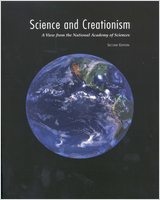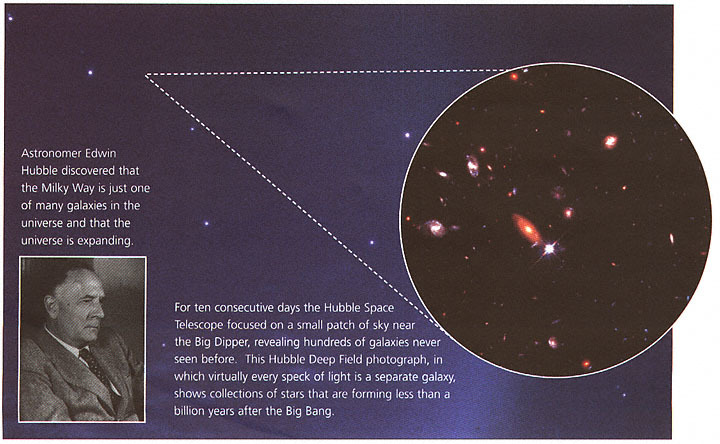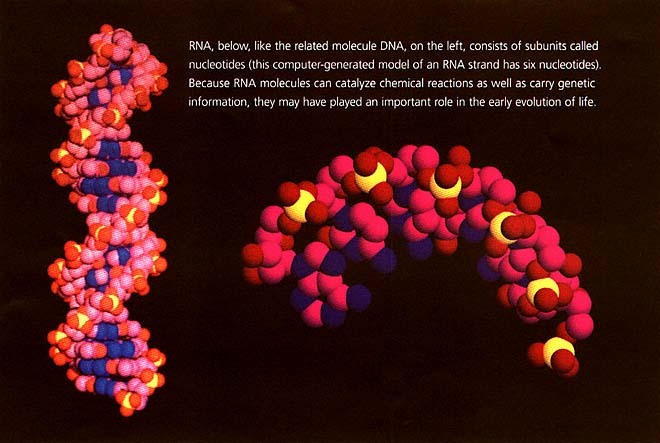NCBI Bookshelf. A service of the National Library of Medicine, National Institutes of Health.
National Academy of Sciences (US). Science and Creationism: A View from the National Academy of Sciences: Second Edition. Washington (DC): National Academies Press (US); 1999.

Science and Creationism: A View from the National Academy of Sciences: Second Edition.
Show detailsThe term "evolution" usually refers to the biological evolution of living things. But the processes by which planets, stars, galaxies, and the universe form and change over time are also types of "evolution." In all of these cases there is change over time, although the processes involved are quite different.
In the late 1920s the American astronomer Edwin Hubble made a very interesting and important discovery. Hubble made observations that he interpreted as showing that distant stars and galaxies are receding from Earth in every direction. Moreover, the velocities of recession increase in proportion with distance, a discovery that has been confirmed by numerous and repeated measurements since Hubble's time. The implication of these findings is that the universe is expanding.
Hubble's hypothesis of an expanding universe leads to certain deductions. One is that the universe was more condensed at a previous time. From this deduction came the suggestion that all the currently observed matter and energy in the universe were initially condensed in a very small and infinitely hot mass. A huge explosion, known as the Big Bang, then sent matter and energy expanding in all directions.

This Big Bang hypothesis led to more testable deductions. One such deduction was that the temperature in deep space today should be several degrees above absolute zero. Observations showed this deduction to be correct. In fact, the Cosmic Microwave Background Explorer (COBE) satellite launched in 1991 confirmed that the background radiation field has exactly the spectrum predicted by a Big Bang origin for the universe.
As the universe expanded, according to current scientific understanding, matter collected into clouds that began to condense and rotate, forming the forerunners of galaxies. Within galaxies, including our own Milky Way galaxy, changes in pressure caused gas and dust to form distinct clouds. In some of these clouds, where there was sufficient mass and the right forces, gravitational attraction caused the cloud to collapse. If the mass of material in the cloud was sufficiently compressed, nuclear reactions began and a star was born.
Some proportion of stars, including our sun, formed in the middle of a flattened spinning disk of material. In the case of our sun, the gas and dust within this disk collided and aggregated into small grains, and the grains formed into larger bodies called planetesimals ("very small planets"), some of which reached diameters of several hundred kilometers. In successive stages these planetesimals coalesced into the nine planets and their numerous satellites. The rocky planets, including Earth, were near the sun, and the gaseous planets were in more distant orbits.
The ages of the universe, our galaxy, the solar system, and Earth can be estimated using modem scientific methods. The age of the universe can be derived from the observed relationship between the velocities of and the distances separating the galaxies. The velocities of distant galaxies can be measured very accurately, but the measurement of distances is more uncertain. Over the past few decades, measurements of the Hubble expansion have led to estimated ages for the universe of between 7 billion and 20 billion years, with the most recent and best measurements within the range of 10 billion to 15 billion years.
The age of the Milky Way galaxy has been calculated in two ways. One involves studying the observed stages of evolution of different-sized stars in globular clusters. Globular clusters occur in a faint halo surrounding the center of the Galaxy, with each cluster containing from a hundred thousand to a million stars. The very low amounts of elements heavier than hydrogen and helium in these stars indicate that they must have formed early in the history of the Galaxy, before large amounts of heavy elements were created inside the initial generations of stars and later distributed into the interstellar medium through supernova explosions (the Big Bang itself created primarily hydrogen and helium atoms). Estimates of the ages of the stars in globular clusters fall within the range of 11 billion to 16 billion years.
A second method for estimating the age of our galaxy is based on the present abundances of several long-lived radioactive elements in the solar system. Their abundances are set by their rates of production and distribution through exploding supernovas. According to these calculations, the age of our galaxy is between 9 billion and 16 billion years. Thus, both ways of estimating the age of the Milky Way galaxy agree with each other, and they also are consistent with the independently derived estimate for the age of the universe.
Radioactive elements occurring naturally in rocks and minerals also provide a means of estimating the age of the solar system and Earth. Several of these elements decay with half lives between 700 million and more than 100 billion years (the half life of an element is the time it takes for half of the element to decay radioactively into another element). Using these time-keepers, it is calculated that meteorites, which are fragments of asteroids, formed between 4.53 billion and 4.58 billion years ago (asteroids are small "planetoids" that revolve around the sun and are remnants of the solar nebula that gave rise to the sun and planets). The same radioactive time-keepers applied to the three oldest lunar samples returned to Earth by the Apollo astronauts yield ages between 4.4 billion and 4.5 billion years, providing minimum estimates for the time since the formation of the moon.
The oldest known rocks on Earth occur in northwestern Canada (3.96 billion years), but well-studied rocks nearly as old are also found in other parts of the world. In Western Australia, zircon crystals encased within younger rocks have ages as old as 4.3 billion years, making these tiny crystals the oldest materials so far found on Earth.
The best estimates of Earth's age are obtained by calculating the time required for development of the observed lead isotopes in Earth's oldest lead ores. These estimates yield 4.54 billion years as the age of Earth and of meteorites, and hence of the solar system.
The origins of life cannot be dated as precisely, but there is evidence that bacteria-like organisms lived on Earth 3.5 billion years ago, and they may have existed even earlier, when the first solid crust formed, almost 4 billion years ago. These early organisms must have been simpler than the organisms living today. Furthermore, before the earliest organisms there must have been structures that one would not call "alive" but that are now components of living things. Today, all living organisms store and transmit hereditary information using two kinds of molecules: DNA and RNA. Each of these molecules is in turn composed of four kinds of subunits known as nucleotides. The sequences of nucleotides in particular lengths of DNA or RNA, known as genes, direct the construction of molecules known as proteins, which in turn catalyze biochemical reactions, provide structural components for organisms, and perform many of the other functions on which life depends. Proteins consist of chains of subunits known as amino acids. The sequence of nucleotides in DNA and RNA therefore determines the sequence of amino acids in proteins; this is a central mechanism in all of biology.
Experiments conducted under conditions intended to resemble those present on primitive Earth have resulted in the production of some of the chemical components of proteins, DNA, and RNA. Some of these molecules also have been detected in meteorites from outer space and in interstellar space by astronomers using radio-telescopes. Scientists have concluded that the "building blocks of life" could have been available early in Earth's history.
An important new research avenue has opened with the discovery that certain molecules made of RNA, called ribozymes, can act as catalysts in modem cells. It previously had been thought that only proteins could serve as the catalysts required to carry out specific biochemical functions. Thus, in the early prebiotic world, RNA molecules could have been "autocatalytic"—that is, they could have replicated themselves well before there were any protein catalysts (called enzymes).

Laboratory experiments demonstrate that replicating autocatalytic RNA molecules undergo spontaneous changes and that the variants of RNA molecules with the greatest autocatalytic activity come to prevail in their environments. Some scientists favor the hypothesis that there was an early "RNA world," and they are testing models that lead from RNA to the synthesis of simple DNA and protein molecules. These assemblages of molecules eventually could have become packaged within membranes, thus making up "protocells"—early versions of very simple cells.
For those who are studying the origin of life, the question is no longer whether life could have originated by chemical processes involving nonbiological components. The question instead has become which of many pathways might have been followed to produce the first cells.
Will we ever be able to identify the path of chemical evolution that succeeded in initiating life on Earth? Scientists are designing experiments and speculating about how early Earth could have provided a hospitable site for the segregation of molecules in units that might have been the first living systems. The recent speculation includes the possibility that the first living cells might have arisen on Mars, seeding Earth via the many meteorites that are known to travel from Mars to our planet.
Of course, even if a living cell were to be made in the laboratory, it would not prove that nature followed the same pathway billions of years ago. But it is the job of science to provide plausible natural explanations for natural phenomena. The study of the origin of life is a very active research area in which important progress is being made, although the consensus among scientists is that none of the current hypotheses has thus far been confirmed. The history of science shows that seemingly intractable problems like this one may become amenable to solution later, as a result of advances in theory, instrumentation, or the discovery of new facts.
Creationist Views of the Origin of the Universe, Earth, and Life
Many religious persons, including many scientists, hold that God created the universe and the various processes driving physical and biological evolution and that these processes then resulted in the creation of galaxies, our solar system, and life on Earth. This belief, which sometimes is termed "theistic evolution," is not in disagreement with scientific explanations of evolution. Indeed, it reflects the remarkable and inspiring character of the physical universe revealed by cosmology, paleontology, molecular biology, and many other scientific disciplines.
The advocates of "creation science" hold a variety of viewpoints. Some claim that Earth and the universe are relatively young, perhaps only 6,000 to 10,000 years old. These individuals often believe that the present physical form of Earth can be explained by "catastrophism," including a worldwide flood, and that all living things (including humans) were created miraculously, essentially in the forms we now find them.
Other advocates of creation science are willing to accept that Earth, the planets, and the stars may have existed for millions of years. But they argue that the various types of organisms, and especially humans, could only have come about with supernatural intervention, because they show "intelligent design."
In this booklet, both these "Young Earth" and "Old Earth" views are referred to as "creationism" or "special creation."
There are no valid scientific data or calculations to substantiate the belief that Earth was created just a few thousand years ago. This document has summarized the vast amount of evidence for the great age of the universe, our galaxy, the solar system, and Earth from astronomy, astrophysics, nuclear physics, geology, geochemistry, and geophysics. Independent scientific methods consistently give an age for Earth and the solar system of about 5 billion years, and an age for our galaxy and the universe that is two to three times greater. These conclusions make the origin of the universe as a whole intelligible, lend coherence to many different branches of science, and form the core conclusions of a remarkable body of knowledge about the origins and behavior of the physical world.
Nor is there any evidence that the entire geological record, with its orderly succession of fossils, is the product of a single universal flood that occurred a few thousand years ago, lasted a little longer than a year, and covered the highest mountains to a depth of several meters. On the contrary, intertidal and terrestrial deposits demonstrate that at no recorded time in the past has the entire planet been under water. Moreover, a universal flood of sufficient magnitude to form the sedimentary rocks seen today, which together are many kilometers thick, would require a volume of water far greater than has ever existed on and in Earth, at least since the formation of the first known solid crust about 4 billion years ago. The belief that Earth's sediments, with their fossils, were deposited in an orderly sequence in a year's time defies all geological observations and physical principles concerning sedimentation rates and possible quantities of suspended solid matter.
Geologists have constructed a detailed history of sediment deposition that links particular bodies of rock in the crust of Earth to particular environments and processes. If petroleum geologists could find more oil and gas by interpreting the record of sedimentary rocks as having resulted from a single flood, they would certainly favor the idea of such a flood, but they do not. Instead, these practical workers agree with academic geologists about the nature of depositional environments and geological time. Petroleum geologists have been pioneers in the recognition of fossil deposits that were formed over millions of years in such environments as meandering rivers, deltas, sandy barrier beaches, and coral reefs.
The example of petroleum geology demonstrates one of the great strengths of science. By using knowledge of the natural world to predict the consequences of our actions, science makes it possible to solve problems and create opportunities using technology. The detailed knowledge required to sustain our civilization could only have been derived through scientific investigation.
The arguments of creationists are not driven by evidence that can be observed in the natural world. Special creation or supernatural intervention is not subjectable to meaningful tests, which require predicting plausible results and then checking these results through observation and experimentation. Indeed, claims of "special creation" reverse the scientific process. The explanation is seen as unalterable, and evidence is sought only to support a particular conclusion by whatever means possible.
- The Origin of the Universe, Earth, and Life - Science and CreationismThe Origin of the Universe, Earth, and Life - Science and Creationism
- capn3b [Epinephelus lanceolatus]capn3b [Epinephelus lanceolatus]Gene ID:117270774Gene
Your browsing activity is empty.
Activity recording is turned off.
See more...
